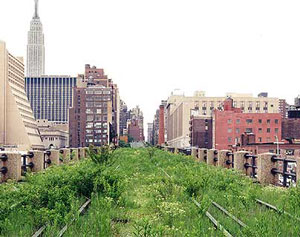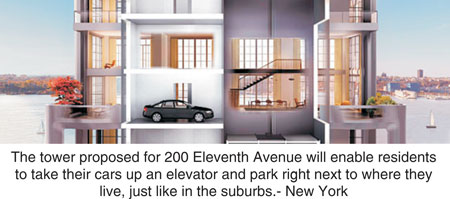BREAKING NEWS
The High Lining of New York
Here comes the neighborhood.
Until now, far West Chelsea has been known primarily for art galleries, auto shops, and vintage warehouses reclaimed as upscale office space. Soon, though, the neighborhood will feature an entirely different skyline: one studded with developments from name-brand architects, offering hot new addresses, Hudson River views, and, of course, stone’s-throw (or, in some cases, walk-out-your-front-door) access to the High Line [an elevated rail line that is now being converted into a city park].
The abandoned railroad that made a park ... that made a neighborhood ...
The High Line is a brand-new park. In the sky. Now, the longer, slightly more complicated version: The High Line is, according to its converts (and they are legion), the happily-ever-after at the end of an urban fairy tale. It’s a “flying carpet,” “our generation’s Central Park,” something akin to “Alice in Wonderland ... through the keyhole and you’re in a magical place.” It’s also the end-product of a perfect confluence of powerful forces: radical dreaming, dogged optimism, neighborhood anxiety, design mania, real-estate opportunism, money, celebrity, and power. In other words, it’s a 1.45-mile, 6.7-square-acre, 30-foot-high symbol of exactly what it means to be living in New York right now.
For twenty years, local property owners were the main opponents to the park-conversion plan. At the height of his battle with Friends of the High Line, Edison Parking’s Jerry Gottesman launched a propaganda campaign. “They had one flyer that said, ‘Money doesn’t grow on trees, and last we checked, it isn’t growing in the weeds of the High Line,’ ” says Robert Hammond. “Now the irony is, money is growing in the weeds of the High Line—for them, and they’re picking it.”
The High Line —by which I mean the park, the neighborhood, the festival, the ballroom, the lounge—will one day look to us like a monument to the time we live in now. A time of great optimism for the city’s future. A time of essentially unfettered growth. A time when a rusted railbed could beget a park, and a park could beget a millionaire’s wonderland. And a time when the city was, for many, never safer, never more prosperous, and never more likely to evoke an unshakable suspicion: that more and more, New York has become like a gorgeous antique that someone bought, refurbished, and restored, then offered back to you at a price you couldn’t possibly afford.
New York |
| June 2007 |
| S |
M |
T |
W |
T |
F |
S |
|
|
|
|
|
|
1
|
2
|
|
3
|
4
|
5
|
6
|
7
|
8
|
9
|
|
10
|
11
|
12
|
13
|
14
|
15
|
16
|
|
17
|
18
|
19
|
20
|
21
|
22
|
23
|
|
24
|
25
|
26
|
27
|
28
|
29
|
30
|
|
|
 |
|
« Previous |
Main Page
| Next »
|
Last Stop for New Highs: NYC's High Line Conversion
By: Pete Kendall, June 13, 2007 |
[New York] state and local pols are rising to the occasion because it’s what they do at major turns. New York City is a lightning rod for social mood.
Sociotimes, April 10, 2007 |

We talked about New York’s special place in the socionomic scheme of things last April when we covered the significance of the T-line, a subway that is back on the mass transit drawing board for the first time since October 1972 and September 1929. As we noted at the time, those dates were very close to the departure points for the two biggest bear market declines of the last century. With its emphasis on “money, celebrity and power,” High Line Park reflects the aura of a peak mood even more strongly. After 20 years, property owners are buying in because that’s when the aura of an expiring bull market ropes in the majority of participants. “This is about optimism,” says actor and High Line advocate Ed Norton. Optimism always wins out in the end. Of course, the whole history of New York tells us what that means: the euphoria must now dissipate and be replaced by the despair and uncertainty that plagued the city in more bearish times, like September 2001 and, to a deeper degree, the mid-1970s.

If the gushing, “end of an urban fairy tale” talk isn’t enough to tell us it’s time, there is the fact that even before High Line Park opens it is being surrounded by upscale real estate developments. In one three-block section, nine different projects are underway. “This is a gold mine,” says warehouse owner Douglas Oliver. The proposals include the 200 Eleventh Ave. building, which will feature the in-unit car park design shown above. As the May issue of The Elliott Wave Financial Forecast noted, luxury plays an all-important supporting role in every mania. In a city where car ownership is unnecessary and extraordinarily expensive, what could be a more perfectly ostentatious display than riding up and down the elevator in a Bugatti (see page 4 of the May issue for a shot of this car and the significance of the latest luxury binge)? The High Line was originally constructed as a rail line for manufacturers in the 1930s. It was closed in 1980 and decayed into an industrial ruin over the course of the great bull market. The social harmony reflected in its rebirth as a park as well as the speculative fury and swarming show of flamboyance in the surrounding real estate make it the perfect place for a classic New York City unwinding. Look for the High Line to become synonymous with something much darker than the urban utopia now envisioned. |
|
Post a comment
|
|
|
 |
| RECENT ARTICLES |
 |
June 14, 2007
Basketball Crowns a New King as a Bear Market Mood Sinks In
read more |
June 13, 2007
Last Stop for New Highs: NYC's High Line Conversion
read more |
June 12, 2007
On a Clear Day, Wall Street Faces a Hurricane of Paper
read more |
June 11, 2007
A Merger Fever Deal Breaker: Whole Foods/Wild Oats
read more |
June 8, 2007
Immigration Bill Failure Uncovers Drop in Racial Unity
read more |
|
|
| ARTICLE COMMENTS |
 |
|
|
|
|
